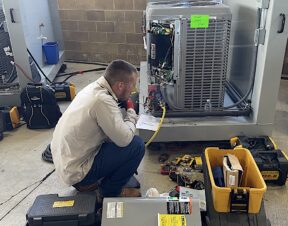Atlanta—Sheila J. Hayter, P.E. 2018-2019 ASHRAE president, and Darryl K. Boyce, P.Eng., 2018-2019 ASHRAE president-elect, testified before the Standing Committee on Natural Resources at the House of Commons of Canada on Tuesday, Nov. 20.
The committee is currently studying economic opportunities for energy efficiency in Canada. ASHRAE provided testimony focused on the technical tools, standards and guidelines it develops that can help government – and the private sector – deliver on energy efficiency and building performance.
During the hearing, Hayter highlighted how ASHRAE resources can help drive sound energy policy, and aid Canada in its development of a nationwide net-zero energy building code, which it aims to complete by 2030, with all provinces and territories adopting and implementing it by 2040.
Hayter shared that ASHRAE is reviewing its existing portfolio of standards to determine the best way to create a zero-energy building standard and would happily share the Society’s knowledge in the area.
“ASHRAE is honored to have had the opportunity to testify before the Standing Committee on Natural Resources,” said Hayter. “We take immense pride in being invited into these important discussions while we work as a Society to spearhead the efforts toward building a new energy future. As Canada moves toward a smart grid, we welcome the opportunity to continue sharing our technical expertise to ensure this transition is done effectively and efficiently, and to also assist in providing the tools, resources, and knowledge to ensure proper operation of buildings in this new paradigm.”
During his testimony, Boyce passionately articulated the importance of optimizing the performance of Canada’s existing buildings, sharing that every $1 million invested in energy efficiency results in $3 to $4 million in economic growth, according to the Pembina Institute. Boyce also emphasized the need to focus on building operations to ensure optimal performance.
“Optimizing Canada’s existing buildings and ensuring effective building operations are key to meeting Canada’s energy and climate commitments,” said Boyce. “Investments in these buildings can also generate solid economic benefits for those who own, operate, live and work in these buildings—and ASHRAE has the resources and tools to help achieve those benefits.”
Boyce particularly pointed out the following tools as resources well-equipped to help Canada achieve its goals.
• ASHRAE Standard 100, Energy Efficiency in Existing Buildings, which sets criteria to reduce energy consumption through improved energy efficiency and performance.
•ANSI/ACCA/ASHRAE Standard 211, Standard for Commercial Building Energy Audits, which outlines the requirements for ASHRAE Level 1, Level 2, and Level 3 energy audits.
• ASHRAE Building EQ, which is a building energy rating program that provides both an operational and asset rating to assess a building’s energy performance. Beyond providing a score, Building EQ can help improve a building’s energy performance after the benchmarking is completed. The Building EQ-In Operation rating assists with an ASHRAE Level 1 energy audit and provides both a standardized process and actionable recommendations for the building.
• ASHRAE Standard 135, BACNET—A Data Communication Protocol for Building Automation and Control Networks, which defines data communication services and protocols for information technology used to monitor building systems and to ensure all building automation systems can “talk” to one another.




Join the conversation: